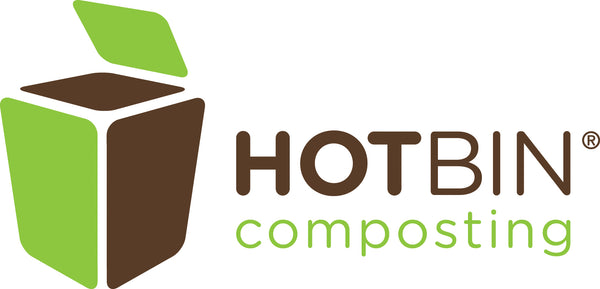7 Secrets of Good HOTBIN Composting
Here are the 7 secrets of hot composting from the HOTBIN team;
- Build the perfect base layer
- Chop and shred waste
- Add a mixture of waste
- Create airflow
- Tackle excess water
- Close the lid tightly
- Empty out the base layer every 3-6 months
1. Build a Perfect Base Layer
When starting your HOTBIN build up a base layer of waste to around 16 in. deep (top of the hatch height). Add easy to digest waste when starting your HOTBIN. Things like grass, chicken pellets, vegetables and peelings, sprinkling of blood/bone meal. Check the waste digestibility table in the user guide.
Remember you may need to reprocess your very first base layer as it rarely fully composts because the base stays cooler due to fresh cool air drawn in.
2. Chop, Shred and Mix Waste
Many plants, fruits and vegetables have defensive bark, shells, peels and skins to protect themselves against bacterial attack. Chopping and or shredding waste can break through these layers and create a greater surface area allowing the bacteria to break down the waste faster. We recommend aiming for all waste to be less 2 in., and preferably less than 1 in.
3. Add a Mixture of Waste
Just like humans, bacteria digest some items faster than others. It helps to keep the temperature hot by adding 'easy to digest' items like: grass, soft green leaves, cooked food and shredded white paper.
Waste can be added to the HOTBIN as it is available, however if you have a large of quantity of one type of waste e.g. grass; it is better to mix it with other types of waste. Layering greens (high in carbon) and browns (high in nitrogen) in the HOTBIN is not necessary, these need to be mixed to maintain effective composting.
If you have old compost avoid adding any large quantities. Add in handfuls and remember as it is already partially composted waste a lot of the food energy will already be gone. You will need to mix with fresh waste to feed the new bacteria that create the heat.
4. Create Airflow
Bacteria needs air to work effectively, to maintain aeration and prevent softer materials (I.e. grass and food waste) forming into a mushy impervious layer air pockets need to be created to allow air to enter the bin at the base and flow up through the bin to leave as steam at the top.
Adding bulking agent (partially composted wood-chip) maintains airflow through the mushy layers by forming a structure around which air can flow and prevents the waste turning anaerobic.
5. Tackle Excess Water...
It is essential for the composting bacteria to have water; but too much water in the HOTBIN will restrict airflow and the temperature can stall.
Typically, most plant waste contains around 50-70% water and as a rule additional water should not be added to the HOTBIN. With cooked waste however it is normal for there to be “too much” water for hot composting.
To balance this moisture content you should add shredded paper or corrugated cardboard every time waste is added to your bin. Other papers may be used but not all are equal in their absorption and decaying properties, consequently we recommend certain paper types over others.
6. Close the Lid After Use
Remember to close the lid after adding new waste. It is essential the HOTBIN lid is closed to retain heat and ensure the temperature gets into the 104-140°F range. It will also help retain odors commonly associated with attracting flies and vermin.
7. Empty every 3-6 months
We recommend you empty the HOTBIN at least every six months, any longer and the compost will start to compress and restrict airflow.
